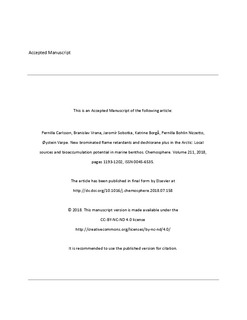| dc.contributor.author | Carlsson, Pernilla | |
| dc.contributor.author | Vrana, Branislav | |
| dc.contributor.author | Sobotka, Jaromír | |
| dc.contributor.author | Borgå, Katrine | |
| dc.contributor.author | Bohlin-Nizzetto, Pernilla | |
| dc.contributor.author | Varpe, Øystein | |
| dc.date.accessioned | 2019-05-29T13:21:58Z | |
| dc.date.available | 2019-05-29T13:21:58Z | |
| dc.date.created | 2018-10-23T09:30:43Z | |
| dc.date.issued | 2018 | |
| dc.identifier.citation | Chemosphere. 2018, 211, 1193-1202. | nb_NO |
| dc.identifier.issn | 0045-6535 | |
| dc.identifier.uri | http://hdl.handle.net/11250/2599466 | |
| dc.description | Embargo until 30 July 2020 | nb_NO |
| dc.description.abstract | The aim of the present study was to investigate the presence and bioaccumulation of new flame retardants (nBFRs), polybrominated diphenyl ethers (PBDEs) and dechlorane plus (DDC-CO) in the marine environment close to an Arctic community. Passive sampling of air and water and grab sampling of sediment and amphipods was used to obtain samples to study long-range transport versus local contributions for regulated and emerging flame retardants in Longyearbyen, Svalbard. BDE-47 and -99, α- and β-tetrabromoethylcyclohexane (DBE-DBCH), syn- and anti-dechlorane plus (DDC-CO) were detected in all investigated matrices and the DDC-COss at higher concentrations in the air than reported from other remote Arctic areas. Water concentrations of ΣDDC-COSs were low (3 pg/L) and comparable to recent Arctic studies. ΣnBFR was 37 pg/L in the water samples while ΣPBDE was 3 pg/L. In biota, ΣDDC-COSs dominated (218 pg/g ww) followed by ΣnBFR (95 pg/g ww) and ΣPBDEs (45 pg/g ww). When compared with other areas and their relative distribution patterns, contributions from local sources of the analysed compounds cannot be ruled out. This should be taken into account when assessing long-range transport of nBFRs and DDC-COs to the Arctic. High concentrations of PBDEs in the sediment indicate that they might originate from a small, local source, while the results for some of the more volatile compounds such as hexabromobenzene (HBBz) suggest long-range transport to be more important than local sources. We recommend that local sources of flame retardants in remote areas receive more attention in the future. | nb_NO |
| dc.language.iso | eng | nb_NO |
| dc.publisher | Elsevier | nb_NO |
| dc.rights | Attribution-NonCommercial-NoDerivatives 4.0 Internasjonal | * |
| dc.rights.uri | http://creativecommons.org/licenses/by-nc-nd/4.0/deed.no | * |
| dc.title | New brominated flame retardants and dechlorane plus in the Arctic: Local sources and bioaccumulation potential in marine benthos | nb_NO |
| dc.type | Journal article | nb_NO |
| dc.type | Peer reviewed | nb_NO |
| dc.description.version | acceptedVersion | nb_NO |
| dc.source.pagenumber | 1193-1202 | nb_NO |
| dc.source.volume | 211 | nb_NO |
| dc.source.journal | Chemosphere | nb_NO |
| dc.identifier.doi | 10.1016/j.chemosphere.2018.07.158 | |
| dc.identifier.cristin | 1622486 | |
| dc.relation.project | Svalbards miljøvernfond: 15/79 | nb_NO |
| dc.relation.project | Arctic Monitoring and Assessment Programme: X | nb_NO |
| cristin.unitcode | 7464,30,21,0 | |
| cristin.unitname | Miljøkjemi | |
| cristin.ispublished | true | |
| cristin.fulltext | postprint | |
| cristin.qualitycode | 1 | |

